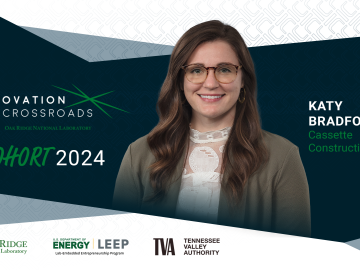
Filter News
Area of Research
- Biology and Environment (43)
- Clean Energy (48)
- Computational Biology (1)
- Computer Science (2)
- Fusion and Fission (20)
- Fusion Energy (4)
- Isotopes (2)
- Materials (30)
- Materials for Computing (7)
- National Security (17)
- Neutron Science (11)
- Nuclear Science and Technology (17)
- Quantum information Science (3)
- Supercomputing (64)
News Type
News Topics
- (-) Buildings (23)
- (-) Computer Science (89)
- (-) Frontier (26)
- (-) Machine Learning (23)
- (-) Mercury (7)
- (-) Microscopy (20)
- (-) Nuclear Energy (56)
- (-) Polymers (8)
- (-) Sustainable Energy (48)
- (-) Transportation (27)
- 3-D Printing/Advanced Manufacturing (43)
- Advanced Reactors (8)
- Artificial Intelligence (51)
- Big Data (30)
- Bioenergy (51)
- Biology (60)
- Biomedical (31)
- Biotechnology (12)
- Chemical Sciences (27)
- Clean Water (15)
- Climate Change (52)
- Composites (8)
- Coronavirus (17)
- Critical Materials (5)
- Cybersecurity (14)
- Decarbonization (47)
- Education (2)
- Emergency (2)
- Energy Storage (30)
- Environment (105)
- Exascale Computing (30)
- Fossil Energy (4)
- Fusion (31)
- Grid (26)
- High-Performance Computing (49)
- Hydropower (5)
- Isotopes (31)
- ITER (2)
- Materials (45)
- Materials Science (48)
- Mathematics (7)
- Microelectronics (3)
- Molten Salt (1)
- Nanotechnology (16)
- National Security (47)
- Net Zero (8)
- Neutron Science (52)
- Partnerships (21)
- Physics (31)
- Quantum Computing (22)
- Quantum Science (32)
- Renewable Energy (1)
- Security (12)
- Simulation (33)
- Software (1)
- Space Exploration (12)
- Statistics (1)
- Summit (32)
- Transformational Challenge Reactor (3)
Media Contacts

Katy Bradford is on a mission to revolutionize the construction industry and is the founder of Cassette Construction, a company in the newest cohort of Innovation Crossroads, a DOE Lab-Embedded Entrepreneurship Program node at ORNL. As an Innovation Crossroads fellow, Bradford and her company will receive technical, financial and networking support to successfully advance the company’s products to the marketplace.

As high-tech companies ramp up construction of massive data centers to meet the business boom in artificial intelligence, one component is becoming an increasingly rare commodity: electricity. Since its formation in 2004, the OLCF has fielded five generations of world-class supercomputing systems that have produced a nearly 2,000 times reduction in energy usage per floating point operation per second, or flops. With decades of experience in making HPC more energy efficient, the OLCF may serve as a resource for best “bang for the buck” practices in a suddenly burgeoning industry.

Office of Science to announce a new research and development opportunity led by ORNL to advance technologies and drive new capabilities for future supercomputers. This industry research program worth $23 million, called New Frontiers, will initiate partnerships with multiple companies to accelerate the R&D of critical technologies with renewed emphasis on energy efficiency for the next generation of post-exascale computing in the 2029 and beyond time frame.

As a mechanical engineer in building envelope materials research at ORNL, Bryan Maldonado sees opportunities to apply his scientific expertise virtually everywhere he goes, from coast to coast. As an expert in understanding how complex systems operate, he’s using machine learning methods to control the process and ultimately optimize performance.

Nuclear physicists at the Department of Energy’s Oak Ridge National Laboratory recently used Frontier, the world’s most powerful supercomputer, to calculate the magnetic properties of calcium-48’s atomic nucleus.

ORNL’s Joshua New was named the 2024 Researcher of the Year by R&D World magazine as part of its R&D 100 Professional Award winners.

Debjani Singh, a senior scientist at ORNL, leads the HydroSource project, which enhances hydropower research by making water data more accessible and useful. With a background in water resources, data science, and earth science, Singh applies innovative tools like AI to advance research. Her career, shaped by her early exposure to science in India, focuses on bridging research with practical applications.

Benjamin Manard, an analytical chemist in the Chemical Sciences Division of the Department of Energy’s Oak Ridge National Laboratory, will receive the 2024 Lester W. Strock Award from the Society of Applied Spectroscopy.

Five researchers at the Department of Energy’s Oak Ridge National Laboratory recently completed an eight-week pilot commercialization coaching program as part of Safari, a program funded by DOE’s Office of Technology Transitions, or OTT, Practices to Accelerate the Commercialization of Technologies, or PACT.

The world’s fastest supercomputer helped researchers simulate synthesizing a material harder and tougher than a diamond — or any other substance on Earth. The study used Frontier to predict the likeliest strategy to synthesize such a material, thought to exist so far only within the interiors of giant exoplanets, or planets beyond our solar system.


